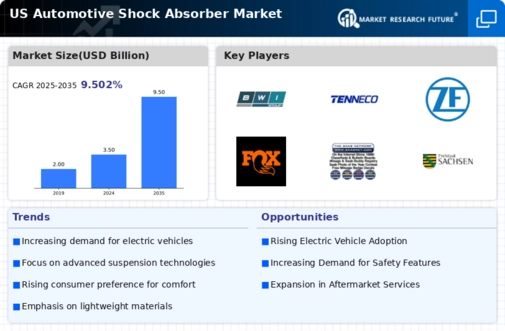Rising Vehicle Production
The automotive shock-absorber market experiences growth driven by the increasing production of vehicles in the United States. In recent years, the automotive industry has seen a surge in demand for new vehicles, with production levels reaching approximately 10 million units annually. This rise in vehicle production directly correlates with the need for high-quality shock absorbers, as manufacturers seek to enhance ride comfort and safety. The automotive shock-absorber market benefits from this trend, as more vehicles on the road necessitate the installation of reliable shock-absorbing systems. Furthermore, the shift towards more complex vehicle designs, including SUVs and crossovers, further amplifies the demand for advanced shock-absorber technologies. As vehicle production continues to rise, the automotive shock-absorber market is poised for sustained growth, reflecting the industry's commitment to improving vehicle performance and passenger comfort.
Growth of Aftermarket Services
The automotive shock-absorber market is experiencing a notable expansion in the aftermarket services sector. As vehicle owners increasingly seek to maintain and enhance their vehicles' performance, the demand for replacement shock absorbers is on the rise. The aftermarket segment is projected to account for a substantial share of the overall market, with estimates suggesting it could reach $3 billion by 2027. This growth is fueled by the aging vehicle population in the United States, where many cars are now over a decade old. Consequently, the automotive shock-absorber market is adapting to cater to this demand by offering a wider range of products, including performance-oriented and budget-friendly options. Additionally, the rise of e-commerce platforms has made it easier for consumers to access shock absorbers, further propelling the aftermarket growth. This trend indicates a robust future for the automotive shock-absorber market as it aligns with consumer preferences for vehicle maintenance.
Increased Focus on Safety Standards
The automotive shock-absorber market is significantly influenced by the heightened emphasis on safety standards within the automotive sector. Regulatory bodies in the United States have implemented stringent safety regulations that require vehicles to meet specific performance criteria. This has led manufacturers to invest in advanced shock-absorber technologies that enhance vehicle stability and control. The automotive shock-absorber market is thus compelled to innovate and develop products that comply with these regulations. For instance, the National Highway Traffic Safety Administration (NHTSA) has established guidelines that directly impact the design and functionality of shock absorbers. As a result, the market is witnessing a shift towards more sophisticated shock-absorber systems that not only improve ride quality but also contribute to overall vehicle safety. This focus on safety is likely to drive demand for high-performance shock absorbers in the coming years.
Technological Integration in Vehicles
The automotive shock-absorber market is increasingly shaped by the integration of advanced technologies in vehicles. Innovations such as adaptive suspension systems and electronically controlled shock absorbers are gaining traction, driven by consumer demand for enhanced driving experiences. These technologies allow for real-time adjustments to shock absorber settings, improving ride comfort and handling. The automotive shock-absorber market is thus witnessing a shift towards high-tech solutions that cater to modern consumer preferences. As automakers continue to incorporate these technologies into their vehicles, the demand for sophisticated shock absorbers is expected to rise. This trend not only enhances vehicle performance but also aligns with the broader movement towards smart vehicle technologies. The potential for growth in this segment is substantial, as more consumers seek vehicles equipped with cutting-edge features that improve overall driving dynamics.
Environmental Regulations and Compliance
The automotive shock-absorber market is increasingly influenced by stringent environmental regulations aimed at reducing vehicle emissions and promoting sustainability. In the United States, regulatory bodies are enforcing standards that require manufacturers to adopt eco-friendly practices in their production processes. This has led to a growing demand for shock absorbers made from sustainable materials and designed to minimize environmental impact. The automotive shock-absorber market is responding to these regulations by innovating and developing products that align with sustainability goals. For instance, manufacturers are exploring the use of recyclable materials and energy-efficient production methods. As environmental concerns continue to shape consumer preferences, the market is likely to see a shift towards greener shock-absorber solutions. This trend not only addresses regulatory requirements but also appeals to environmentally conscious consumers, potentially driving growth in the automotive shock-absorber market.




















Leave a Comment